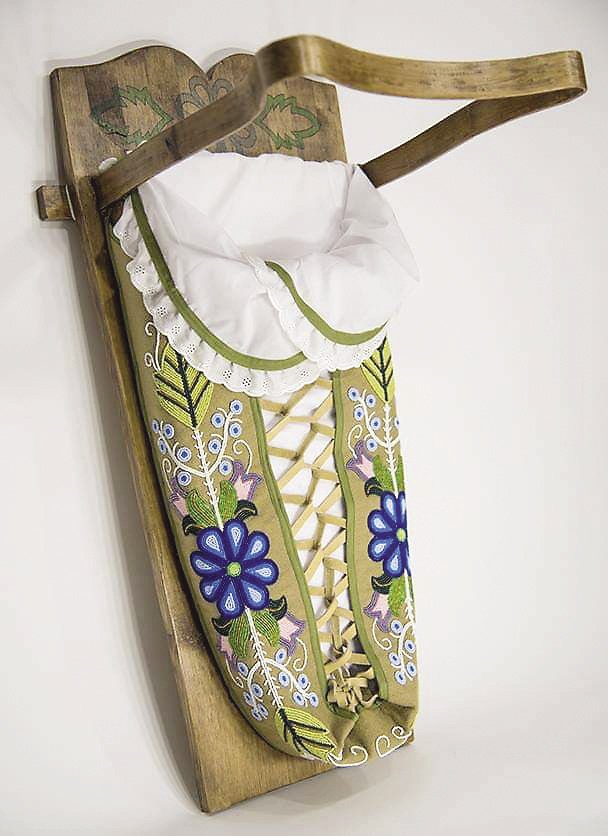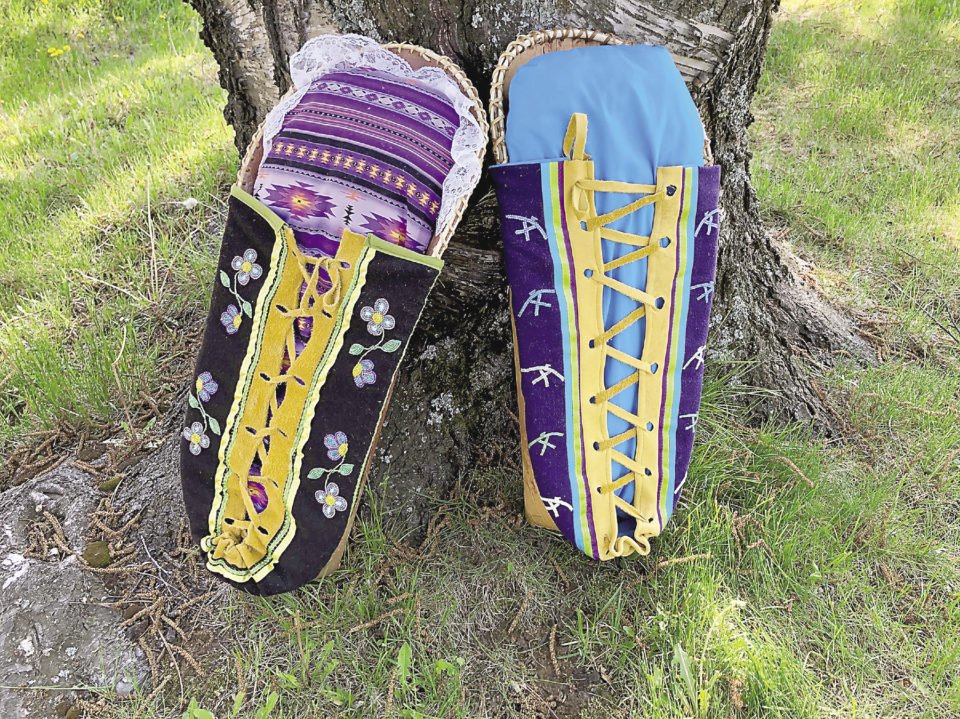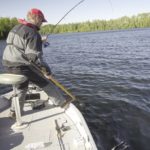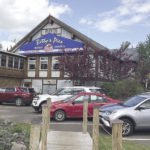They go by different names like the waagijiipizin or moss bag, the tikinagan or the cradleboard. They are all baby carriers that the Anishinaabe have used since time immemorial and that embodies their way of thinking of family and baby; the child at the center of all, wrapped up tightly to feel safety and belonging.
Across Anishinaabe territory, artists, community members, and workers are keeping traditional knowledge alive by teaching Anishinaabe people how to make their own baby carrier. There are three types of cradleboards and they all have some common elements. They all have a solid backing for support. They all wrap the baby up tightly by tieing up the front with leather. And they are typically made by family when a loved one is expecting a newborn baby. We can see kinship law through the tikanagan.
Waagijiipizin
MOSS BAGS
Lynda Banning is Anishinaabe from Fort William First Nation, next to Thunder Bay. She runs the FASD Regional Program for Anishinabek Nation and offers a moss bag teaching. She invites mothers and fathers and community elders to her workshops. They learn the intricate steps of how to make a moss bag, the health benefits to baby, and the history of how the Anishinaabeg have been using and making these bags since the beginning of time.
But due to the violent disconnect of colonialism, there was no value placed on Indigenous knowledge, tikanagans included.
“We’re encouraging connection between mom and dad and the developing fetus,” notes Banning. “By making a moss bag, they are establishing that connection; the baby is becoming real, and they’re working together to prepare for the baby, and generally, that’s the way it was,”
“Spirit to spirit is what it’s mostly about,” she says.
The moss bag was more than just a carrier.
“Traditionally, the moss bag was stuffed with moss and used as the baby’s diaper and you would wash out the moss, hang it to dry and reuse it,” said Banning. “It wasn’t a disposable diaper that would get thrown away. Moss has antiseptic properties and healing properties so the baby would never get diaper rash.”
Wiigwaas adikinaagan
BIRCH BARK CARRIER
Helen Pelletier is another Anishinaabe woman from Fort William First Nation. She has made birch bark baby carriers for her niece Olivia’s children.
“My niece is super special to me, all my nieces are more than nieces to me,” said Pelletier. “So when she asked me to make her a birch bark carrier I said I’d make it happen, because Olivia loves to be Anishinaabe and does anything to incorporate this into her life, [and] her children’s lives. Her way of life is important to her, so when I see a love of culture I make it happen.”
The carrier is made of birch bark that is supported with more bark to make it solid, held together with dogwood, and sewn together with spruce root. The moss bag, sewn onto the birch bark, is made with sought out material, beadwork of Ojibwe florals and thunderbirds, and the front ties up with leather.
Pelletier is humble about her artwork and doesn’t often think of herself as an artist. Art is her connection to family, community, land, and knowledge. It’s also a form of governance and keeps her culture alive. She loves to create and is inspired by all the artwork she sees in life made by family and friends. To her, she is developing relationships with the materials she uses, and she maintains good relations with those she learns from and even teaches.
“I want our babies to feel the love of the earth, where all the materials come from, the birch bark, the spruce roots, and dogwood,” she says.
She beads florals onto the moss bag and has even partnered with Anishinaabe artist, Deanna Therriault, to paint an image on the back of one of the carriers she made.
Community members from Fort William want to follow suit. After Pelletier made the first birch bark carrier for her niece, others have asked her for teachings on how to make a birch bark baby carrier. This is what Anishinaabe governance looks like: sharing, generosity, and maintaining good relations with those around you. Pelletier is proud that community members are choosing traditional knowledge, developing relationships to the land and each other, and placing value on culture as a way of life, so she offers to share her knowledge. There is healing in the land and knowing where you come from and hope when you pass this knowledge down to the next generation, she says.

“Every year I build a relationship with different trees, birch bark, and maple and cedar, and when I build those relationships, I’m getting closer to our ancestors and culture,” says Pelletier.
Tikinagan
CRADLEBOARD
Shannon and Ryan Gustafson are two Anishinaabe artists from Whitesand First Nation who now call Thunder Bay home. They specialize in Indigenous fine arts, creating everything from beadwork to textiles, porcupine roach headdresses to tikinagans. Six years ago, they both left full-time employment with benefits, to devote themselves to learning and sharing their cultural knowledge. It took them six months to learn how to make a tikinagan. Since learning this craft, the two of them have traveled to more than 30 First Nations, covering thousands of kilometers.
The tikinagan is a plank of wood, usually cedar or black ash, almost double the length of a backpack, and not very wide. A wooden bush bar arches across the top, which acts as a protector when a blanket is placed overtop. While mom would travel with the tikinagan on her back, she could feel confident that no branches would swing back to hit the baby. A moss bag is secured to the board offering baby a place to be comfortable while taking in their surroundings.
The Gustafsons raised their children with a core value of being connected to the land through art, powwow, and dance. From birth they started off life wrapped up tightly in the tikinagan, “the middle child not so much” laughs Shannon. They carved out a place where their children could feel safe and be free of racism. A place to feel proud of who you are and where you come from.
They say their children developed their senses of hearing, sight, smell, self-discipline, and impulse control while bound in a moss bag.
“Tikanangans keep our children disciplined, they keep them grounded, they keep them connected to the earth, all those things the cradleboard are made of comes from the earth and it creates that connection,” says Shannon.
While the teachings around each carrier may vary from community to community, some things remain the same. Parents can rest assured knowing the baby is warm, safe and protected, and learning.
In addition to the people noted above, the author would like to thank Alex Kahsenniio Nahwegahbow for sharing her knowledge for this story.




